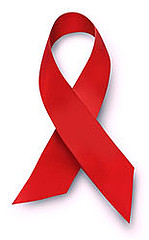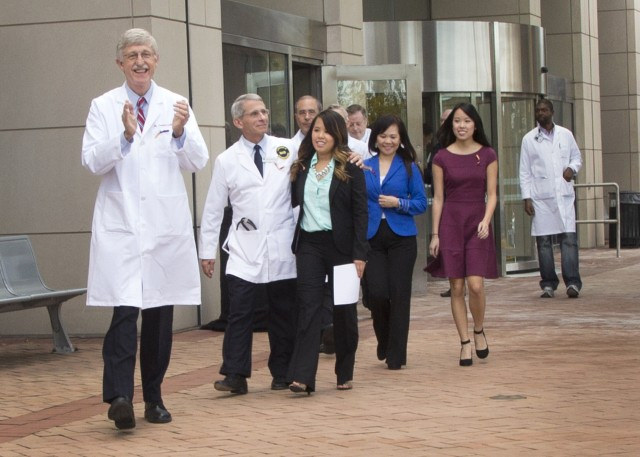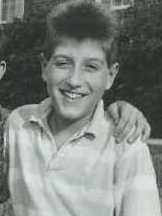NIAID photo
Nina Pham, the Texas nurse who cared for Ebola patient Eric Duncan, leaves National Institutes of Health after being declared free of the disease.
…………………………………………………………………………………………………………………………………………
A Legacy of AIDS in Ebola
By Molly Krause
I was listening to the radio, making a sandwich, when I heard that Eric Duncan had died. I lost my appetite. Media coverage of Duncan, the first known Ebola patient on American soil, had been reminding me of another patient I hadn’t thought of in years—Ryan White. A sick feeling came over me when I heard Ryan died, too, back in 1990.
Ryan White felt to me like a distant brother. We were born just a week apart in December 1971 — he in Indiana, I in Kansas. I first saw him on the Phil Donahue Show talking about contracting HIV during the blood transfusions he received as a hemophiliac. He’d been expelled from middle school due to fear of transmission and ostracized by his community due to their ignorance of the disease; Ryan and his family took his fight to return to school to the courts and to the media. His image on the small black and white screen in my childhood living room showed a polite, pale boy prone to smiling. He was charming. He was adorable. And he had AIDS. Ryan’s personality seemed the exact opposite of the only other person I knew around that time who was HIV positive: My father.
My dad, an excessively sarcastic chain-smoker, was living in New York City when he was diagnosed. He told me and my sisters about his illness during a family therapy session in 1986, about a year after we found out he was gay. My sisters and I didn’t spend much time with him; he’d moved away from Kansas after coming out to my mom fourteen years prior. This was, of course, before gay marriage was even a consideration, before Tom Hanks portrayed a sympathetic AIDS victim in “Philadelphia,” before “Will & Grace” put gay men front-and-center on TV. It was a time when, in a Midwestern city like my own, it was perfectly acceptable to call homosexuals “fags” or “dykes.” Sharpening the situation for my family, we lived in Topeka, where an infamous “preacher” relentlessly picketed street corners with messages such as “AIDS cures fags” and “Fags die God laughs.”
It took me a year to tell my closest friend that my dad was gay, several more years to talk about his illness. At that same moment I was grappling with a personal yearning to speak the truth of my family, Ryan was appearing on TV, giving public presence to a misunderstood disease. Ryan, a child, couldn’t be dismissed with the gays and the IV drug users — the ones, society’s initial characterization of HIV-contraction suggested, who probably deserved it. Fear of the disease itself and whoever happened to carry it persisted; when Ryan and his family ate at local restaurants in the 1980s, workers threw out the plates and silverware they had used. A bullet was shot through the front window of their house. But Ryan’s bravery, coupled with his very palatably white, innocent, young visage, shifted America’s psychology away from identity-based prejudice and toward the scientific causes for AIDS.

Photo by Sully Pixel 
Meanwhile, Ryan’s very survival spoke to the more physical matter of my dad’s mortality. When he was diagnosed in 1984, Ryan was given six months to live. Three years later, he was still alive making public appearances to raise money and awareness for AIDS research. I thought maybe he could beat this death sentence; if anyone could, surely it was this earnest Midwestern boy. Maybe even my dad had a chance. I watched Ryan not just as an inspired sister but as a scared, hopeful daughter.
While we’ve come a long way since then, fear of infection and the illogical assumptions that result persist today around AIDS. A couple weeks after Eric Duncan died from Ebola — and thirty years after Ryan White was thrown out of middle school for having HIV — a viewer asked televangelist Pat Robertson for advice about traveling to Kenya and the danger of Ebola exposure. Robertson’s answer quickly jumped back a few decades: Be very careful because, he said, “the towels could have AIDS.”
Even as many now have a better grip on the way HIV/AIDS is transmitted, current media coverage of Ebola centers on panic and emotion rather than on facts. News outlets have reported that the two Dallas nurses who contracted the Ebola virus while caring for Eric Duncan had what the Center for Disease Control called a “breach in protocol.” In lieu of specifics that might teach us about the nature of the disease itself, this general analysis of the women — utilizing a phrase generally reserved for national security — implies they were just a little deserving of their diagnosis.
CDC Spokesman Tom Skinner said, “Meticulous adherence to protocols” is critical in the treatment of Ebola. “One slip can result in someone becoming infected,” he continued, “The protocols work.” Carelessness or incompetence then, were the cause of their infection we are led to believe. The systemic training of those on the frontlines of health care do not ease our emotional fears of transmission of this mysterious disease. Discussions of proper equipment usage and training do not make the headlines; nurses who didn’t follow the rules do. As with the AIDS patients of the past, behaviors of the victims are given preference for coverage over the behaviors of the virus. Their personal blame serves to calm our frazzled nerves. They’re no Ryan White. They breached protocol.
Ryan himself wanted no part in being portrayed as innocent. His mother told the New York Times in 1992, “Ryan always said, ‘I’m just like everyone else with AIDS, no matter how I got it.’” She credited the gay community with extending the length of Ryan’s life by making the family aware of the latest treatments before they were in practice in Indiana. Ryan once posed in a photograph with Elton John wearing a sequined hat. But his image was that of the perfect Midwestern boy.
My dad once bore the weight of that same image. Born in Manhattan, Kansas, at the outset of World War II, he insisted until his death that he coined the college town’s nickname, “the Little Apple.” Coming of age in the conformity-exalting 1950s, living with his older sister and architect parents in a middle-class, middle-America world, he made the predictable and understandable choice of trying to live a straight life — the sort of choice Pat Robertson would endorse. He married. He had three daughters. Then he contracted the HIV virus — not from a towel but from unprotected sex with a man.
He was, in fact, the feared stereotype. He was also my dad.
One day in April 1990 I came home from high school to see on the TV news that Ryan White had died. No one was home. I sat on my couch and sobbed. Ryan wasn’t planning for prom like I was. Ryan wouldn’t go to college in the fall like I would. He was dead, and I knew my dad was doomed to succumb, too. The antiretrovirals that have since saved thousands of lives would not save him. But both outlived doctors’ expectations — Ryan by over five years, my dad by nearly ten.
During the holidays in 1996, having come back from New York, Dad was in Topeka wasting away to die in December. On our way to and from the hospital, we often passed my hometown’s clan of picket-signed hate-mongers. Dad would wave a dismissive hand towards the car window, his eyesight too poor to read the signs by then. He knew what they said. Never the gentle thing that Ryan White was, he gave them the finger as we passed for good measure.
An image has been circulating in social media juxtaposing a photo of President Obama hugging the nurse who survived Ebola after contracting the virus from Eric Duncan, with a decades-old photo of Princess Diana holding an HIV-infected child. When it was new, around the peak of AIDS paranoia, the snapshot of Princess Di became a symbol for transforming public misconceptions of disease and cruelty toward its carriers. Perhaps, amid Ebola fears, we again need such symbols.
I hope, though, that we don’t need another Ryan White. When I see today’s media coverage, I pause and pray that we’re past needing one sympathetic person to engender compassion for those diagnosed with Ebola. I pray we’re past convenient assignment of the diagnosis itself to behaviors deemed amoral — gay sex, say, or any other breach of protocol.
f
About the Author:



amen. Beautifully written Molly. Thank you for sharing your gift with us.
Thank you Betsy!
Very touching. Very edifying. And very well-written. I totally agree with your concluding point.
Thank you for taking the time to read and respond.